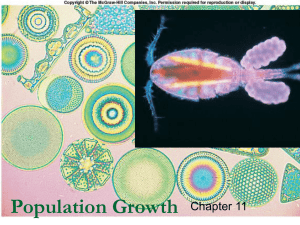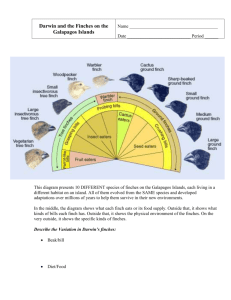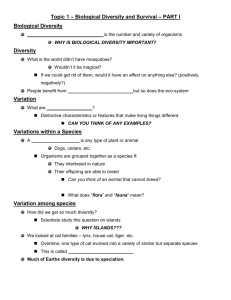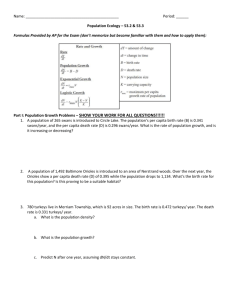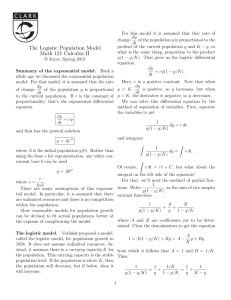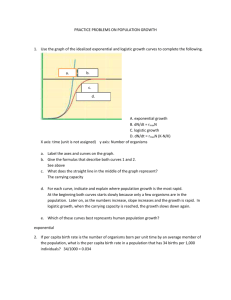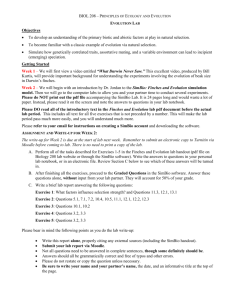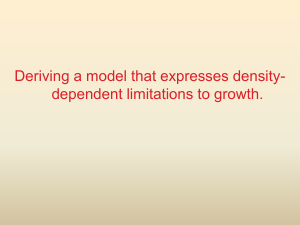Population Growth
advertisement
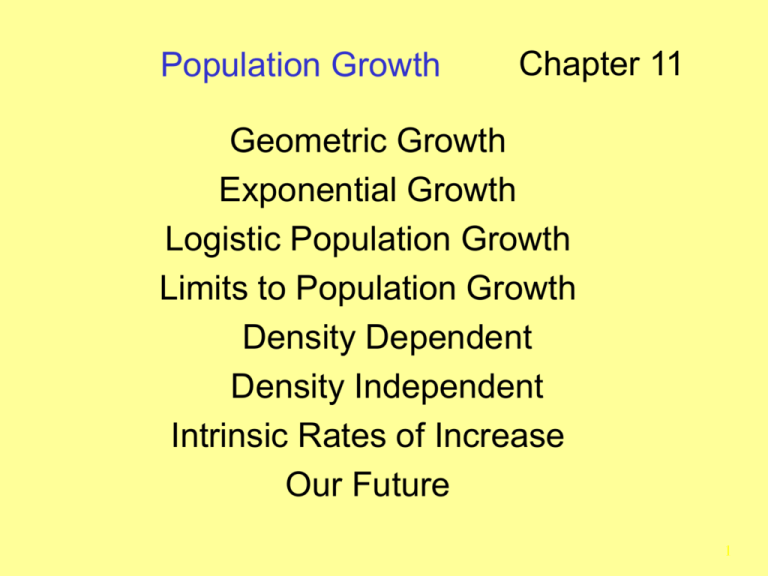
Population Growth Chapter 11 Geometric Growth Exponential Growth Logistic Population Growth Limits to Population Growth Density Dependent Density Independent Intrinsic Rates of Increase Our Future 1 Geometric Growth • When generations do not overlap, growth can be modeled geometrically. N t = N oλ t Nt = Number of individuals at time t. No = Initial number of individuals. λ = Geometric rate of increase. t = Number of time intervals or generations. 2 Exponential Growth • Continuous population growth in an unlimited environment can be modeled exponentially. dN / dt = rmax N • Appropriate for populations with overlapping generations. As population size (N) increases, rate of population increase (dN/dt) gets larger. 3 Exponential Growth • • • • • • For an exponentially growing population, size at any time can be calculated as: Nt = Noert Nt = Number individuals at time t. N0 = Initial number of individuals. e = Base of natural logarithms. rmax = Per capita rate of increase. t = Number of time intervals. 4 Exponential Growth of Human Population The Black Death! www.globalchange.umich.edu/.../human_pop.html 5 Logistic Population Growth • As resources are depleted, population growth rate slows and eventually stops, this is called logistic population growth. Sigmoid (S-shaped) pop. growth curve. Carrying capacity (K) is the number of individuals of a population the environment can support. A finite amount of resources can only support a finite number of individuals. 6 Logistic Population Growth 7 8 Logistic Population Growth dN/dt = rmaxN(1-N/K) • • • • • • rmax = Maximum per capita rate of increase under ideal conditions. rmax occurs at extremely low population size. Growth rate (dN/dt) is greatest when N=K/2. When N nears K, the both (1-N/K) and r approach zero. N/K = Environmental resistance; defines when resources limit further growth. If N>K, then dN/dt is negative; population declines. 9 Limits to Population Growth • Environment limits population growth by altering birth and death rates. Density-dependent factors Disease, Resource competition Density-independent factors Natural disasters 10 Galapagos Finch Population Growth • Boag and Grant - Geospiza fortis was numerically dominant finch (1,200). • After drought of 1977, population fell to (180). Food plants failed to produce seed crop. • 1983 - 10x normal rainfall caused population to grow (1,100) due to abundance of seeds for adults and caterpillars nestlings. 11 Galapagos Finch Population Growth 12 Cactus Finches and Cactus Reproduction • Grant and Grant documented several ways finches utilized cacti: Open flower buds in dry season to eat pollen Consume nectar and pollen from mature flowers Eat seed coating (aril) Eat seeds Eat insects from rotting cactus pads 13 Cactus Finches and Cactus Reproduction • Finches tend to destroy stigmas, thus flowers cannot be fertilized. Wet season activity may reduce seeds available to finches during the dry season. Opuntia helleri main source for cactus finches. Negatively impacted by El Nino (1983). Stigma snapping delayed recovery. – Interplay of biotic and abiotic factors. 14 Population Growth by Small Marine Invertebrates • Populations of marine pelagic tunicate (Thalia democratica) grow at exponential rates in response to phytoplankton blooms. Numerical response can increase population size dramatically due to extremely high reproductive rates. 15 Intrinsic Rates of Increase (r) • On average, small organisms have higher rates of per capita increase and more variable populations than large organisms. 16 Our Future? 17 18
